Unit3 Holiday Fun教案(4个课时)
文档属性
| 名称 | Unit3 Holiday Fun教案(4个课时) | 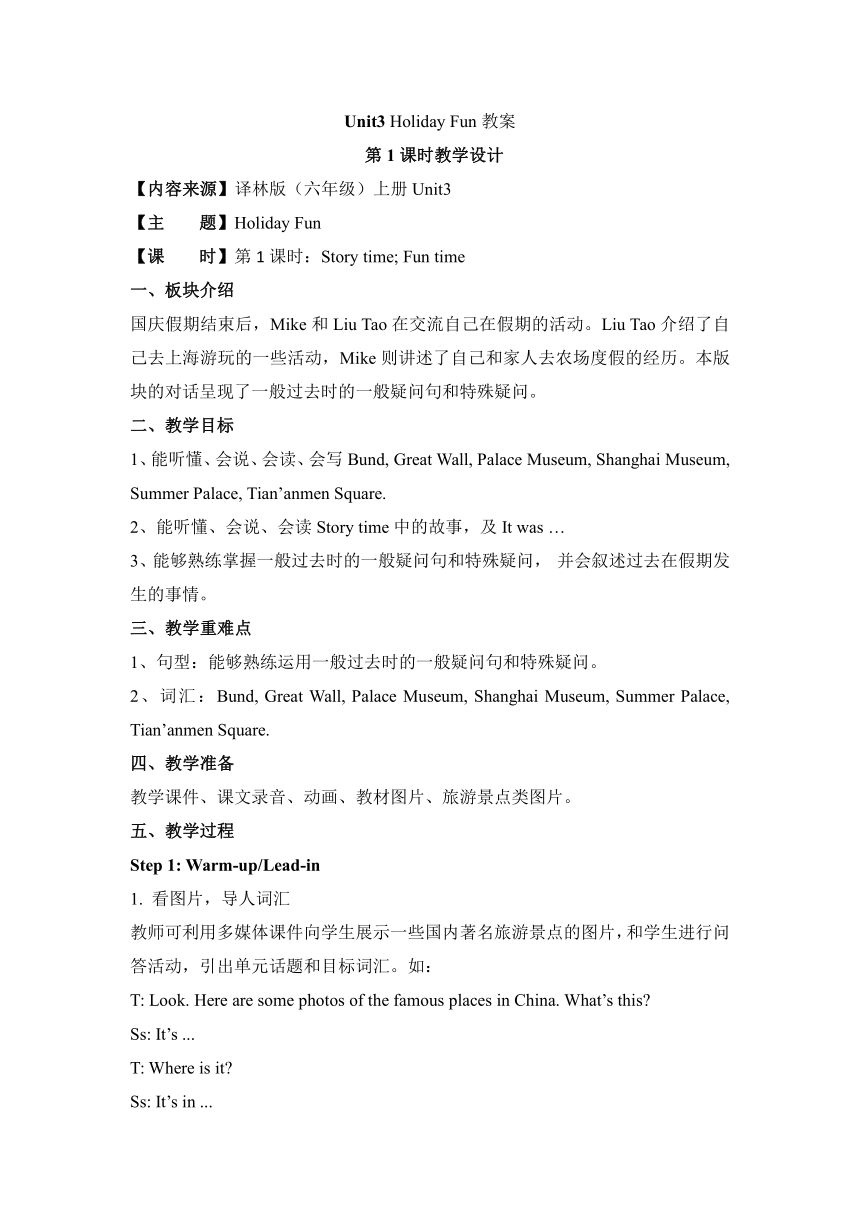 | |
| 格式 | doc | ||
| 文件大小 | 62.0KB | ||
| 资源类型 | 教案 | ||
| 版本资源 | 牛津译林版 | ||
| 科目 | 英语 | ||
| 更新时间 | 2021-06-23 14:00:25 | ||
图片预览

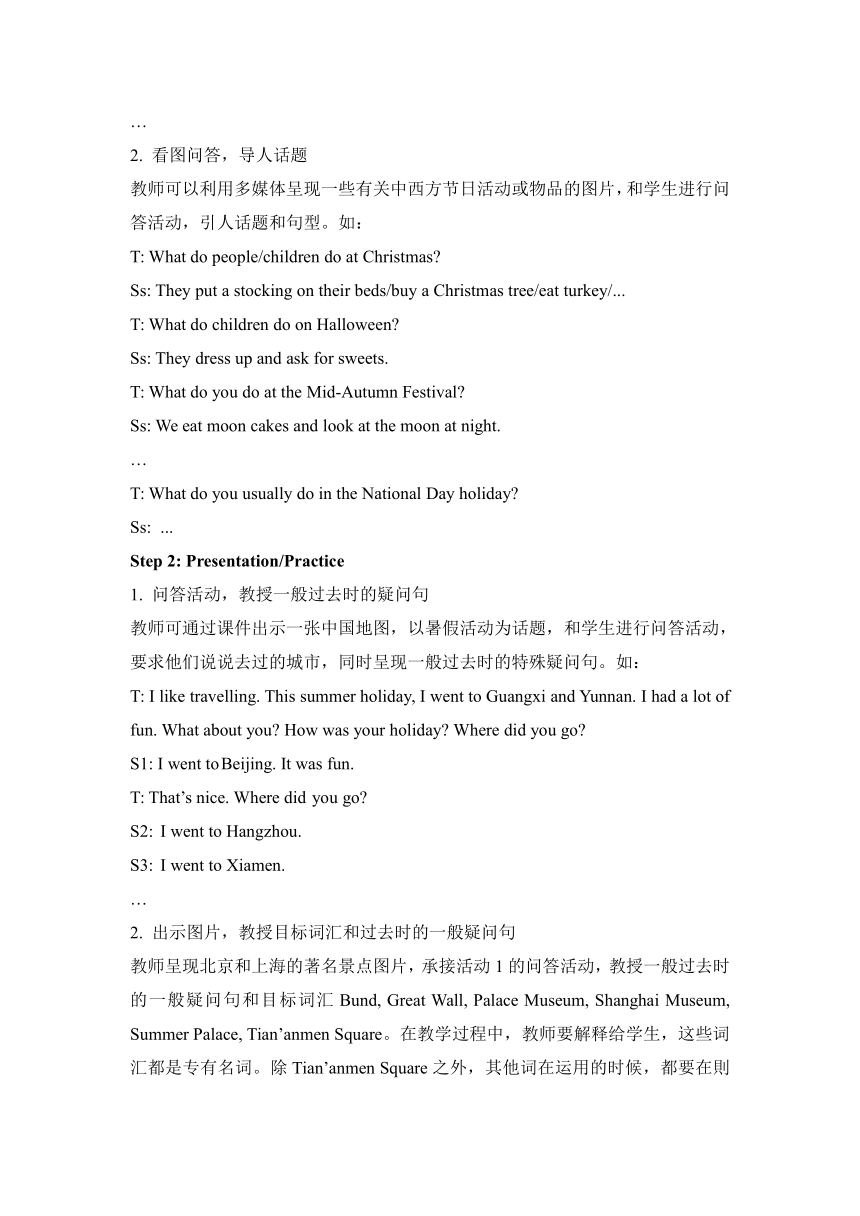
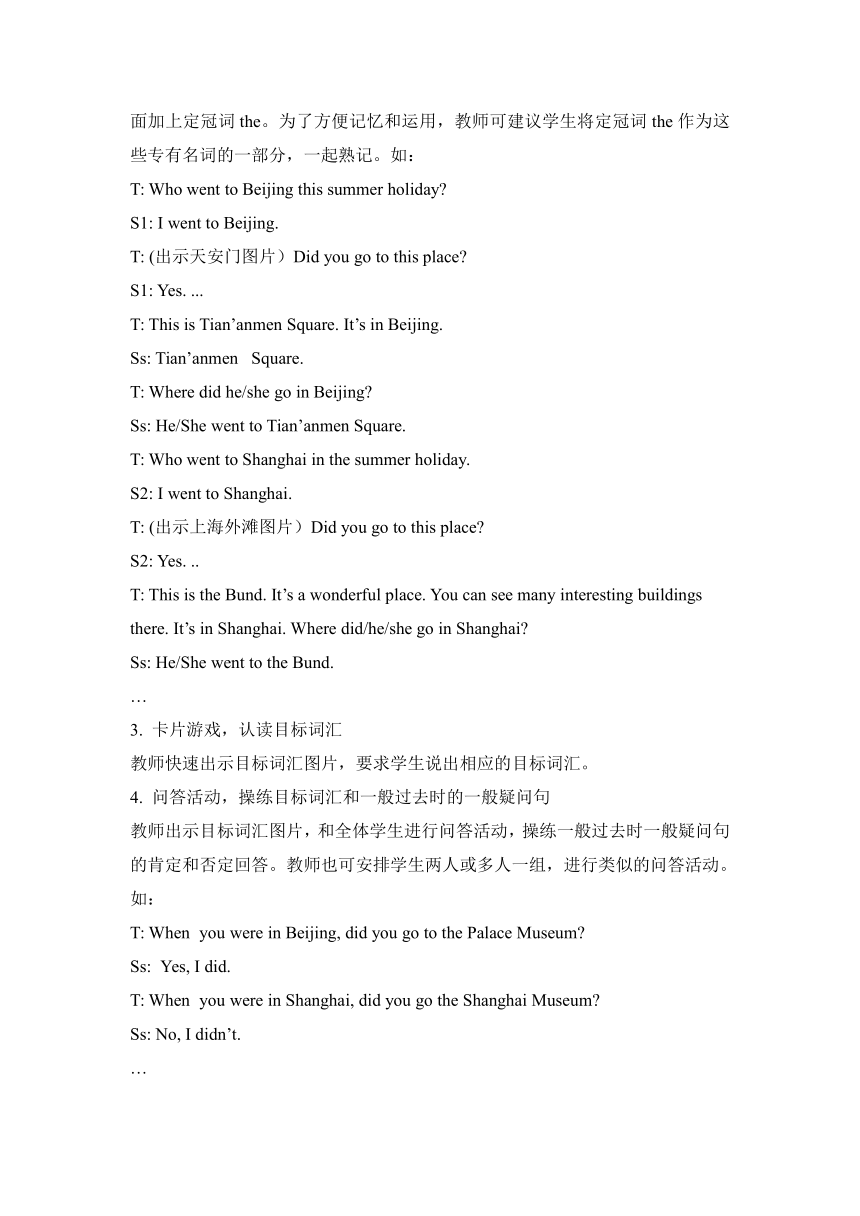
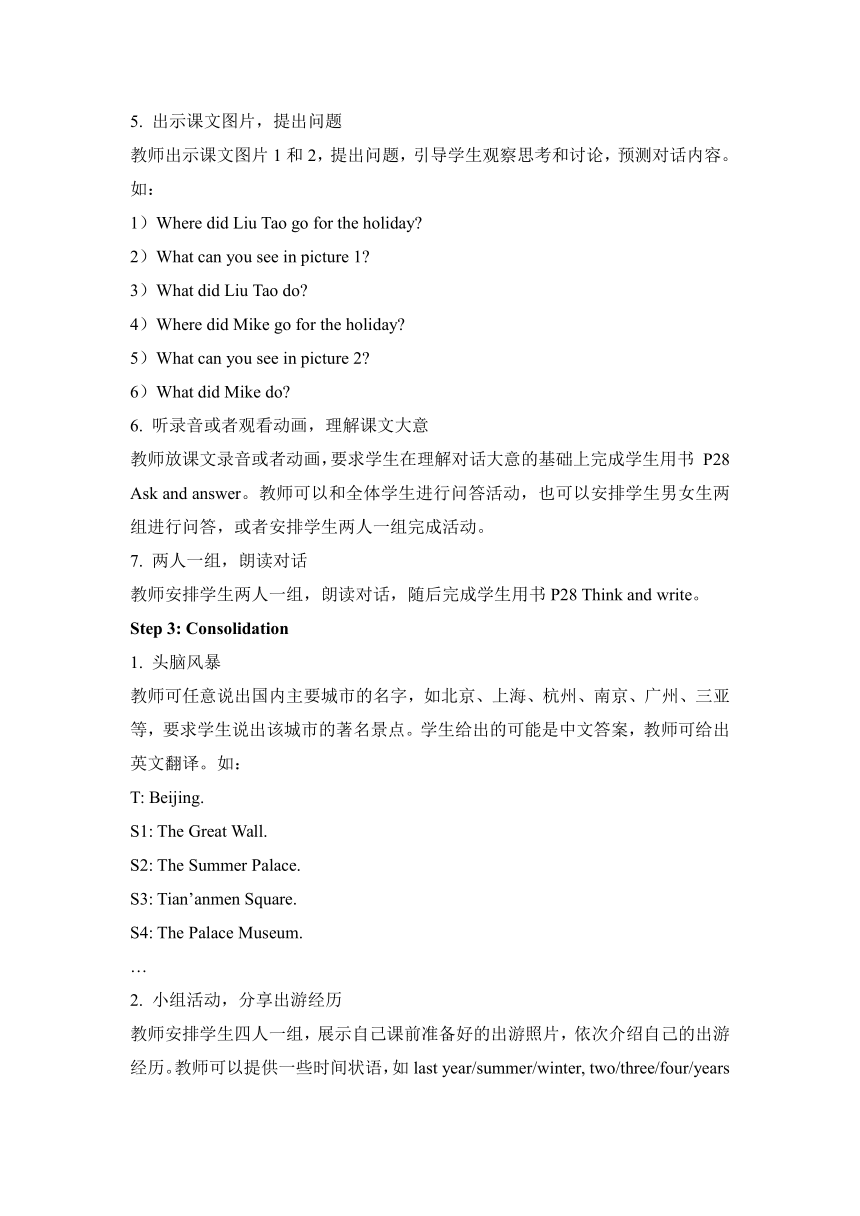
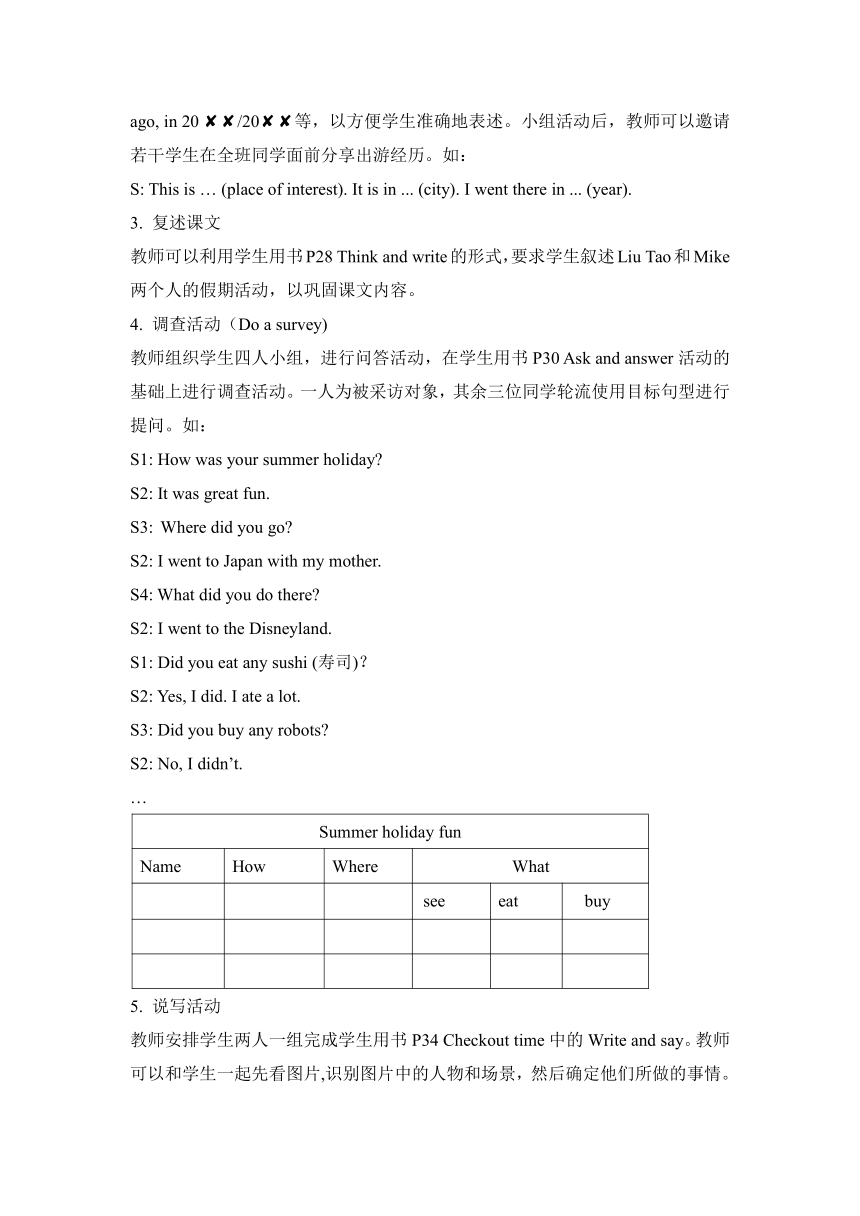
文档简介
Unit3 Holiday Fun教案
第1课时教学设计
【内容来源】译林版(六年级)上册Unit3
【主 题】Holiday Fun
【课 时】第1课时:Story time; Fun time
一、板块介绍
国庆假期结束后,Mike和Liu Tao在交流自己在假期的活动。Liu Tao介绍了自己去上海游玩的一些活动,Mike则讲述了自己和家人去农场度假的经历。本版块的对话呈现了一般过去时的一般疑问句和特殊疑问。
二、教学目标
1、能听懂、会说、会读、会写Bund, Great Wall, Palace Museum, Shanghai Museum, Summer Palace, Tian’anmen Square.
2、能听懂、会说、会读Story time中的故事,及It was …
3、能够熟练掌握一般过去时的一般疑问句和特殊疑问, 并会叙述过去在假期发生的事情。
三、教学重难点
1、句型:能够熟练运用一般过去时的一般疑问句和特殊疑问。
2、词汇:Bund, Great Wall, Palace Museum, Shanghai Museum, Summer Palace, Tian’anmen Square.
四、教学准备
教学课件、课文录音、动画、教材图片、旅游景点类图片。
五、教学过程
Step 1: Warm-up/Lead-in
1. 看图片,导人词汇
教师可利用多媒体课件向学生展示一些国内著名旅游景点的图片,和学生进行问答活动,引出单元话题和目标词汇。如:
T: Look. Here are some photos of the famous places in China. What’s this?
Ss: It’s ...
T: Where is it?
Ss: It’s in ...
…
2. 看图问答,导人话题
教师可以利用多媒体呈现一些有关中西方节日活动或物品的图片,和学生进行问 答活动,引人话题和句型。如:
T: What do people/children do at Christmas?
Ss: They put a stocking on their beds/buy a Christmas tree/eat turkey/...
T: What do children do on Halloween?
Ss: They dress up and ask for sweets.
T: What do you do at the Mid-Autumn Festival?
Ss: We eat moon cakes and look at the moon at night.
…
T: What do you usually do in the National Day holiday?
Ss: ...
Step 2: Presentation/Practice
1. 问答活动,教授一般过去时的疑问句
教师可通过课件出示一张中国地图,以暑假活动为话题,和学生进行问答活动,要求他们说说去过的城市,同时呈现一般过去时的特殊疑问句。如:
T: I like travelling. This summer holiday, I went to Guangxi and Yunnan. I had a lot of fun. What about you? How was your holiday? Where did you go?
S1: I went to Beijing. It was fun.
T: That’s nice. Where did you go?
S2: I went to Hangzhou.
S3: I went to Xiamen.
…
2. 出示图片,教授目标词汇和过去时的一般疑问句
教师呈现北京和上海的著名景点图片,承接活动1的问答活动,教授一般过去时 的一般疑问句和目标词汇Bund, Great Wall, Palace Museum, Shanghai Museum, Summer Palace, Tian’anmen Square。在教学过程中,教师要解释给学生,这些词汇都是专有名词。除Tian’anmen Square之外,其他词在运用的时候,都要在則面加上定冠词the。为了方便记忆和运用,教师可建议学生将定冠词the作为这些专有名词的一部分,一起熟记。如:
T: Who went to Beijing this summer holiday?
S1: I went to Beijing.
T: (出示天安门图片)Did you go to this place?
S1: Yes. ...
T: This is Tian’anmen Square. It’s in Beijing.
Ss: Tian’anmen Square.
T: Where did he/she go in Beijing?
Ss: He/She went to Tian’anmen Square.
T: Who went to Shanghai in the summer holiday.
S2: I went to Shanghai.
T: (出示上海外滩图片)Did you go to this place?
S2: Yes. ..
T: This is the Bund. It’s a wonderful place. You can see many interesting buildings
there. It’s in Shanghai. Where did/he/she go in Shanghai?
Ss: He/She went to the Bund.
…
3. 卡片游戏,认读目标词汇
教师快速出示目标词汇图片,要求学生说出相应的目标词汇。
4. 问答活动,操练目标词汇和一般过去时的一般疑问句
教师出示目标词汇图片,和全体学生进行问答活动,操练一般过去时一般疑问句 的肯定和否定回答。教师也可安排学生两人或多人一组,进行类似的问答活动。 如:
T: When you were in Beijing, did you go to the Palace Museum?
Ss: Yes, I did.
T: When you were in Shanghai, did you go the Shanghai Museum?
Ss: No, I didn’t.
…
5. 出示课文图片,提出问题
教师出示课文图片1和2,提出问题,引导学生观察思考和讨论,预测对话内容。 如:
1)Where did Liu Tao go for the holiday?
2)What can you see in picture 1?
3)What did Liu Tao do?
4)Where did Mike go for the holiday?
5)What can you see in picture 2?
6)What did Mike do?
6. 听录音或者观看动画,理解课文大意
教师放课文录音或者动画,要求学生在理解对话大意的基础上完成学生用书 P28 Ask and answer。教师可以和全体学生进行问答活动,也可以安排学生男女生两组进行问答,或者安排学生两人一组完成活动。
7. 两人一组,朗读对话
教师安排学生两人一组,朗读对话,随后完成学生用书P28 Think and write。
Step 3: Consolidation
1. 头脑风暴
教师可任意说出国内主要城市的名字,如北京、上海、杭州、南京、广州、三亚等,要求学生说出该城市的著名景点。学生给出的可能是中文答案,教师可给出英文翻译。如:
T: Beijing.
S1: The Great Wall.
S2: The Summer Palace.
S3: Tian’anmen Square.
S4: The Palace Museum.
…
2. 小组活动,分享出游经历
教师安排学生四人一组,展示自己课前准备好的出游照片,依次介绍自己的出游经历。教师可以提供一些时间状语,如last year/summer/winter, two/three/four/years ago, in 20 ??/20??等,以方便学生准确地表述。小组活动后,教师可以邀请若干学生在全班同学面前分享出游经历。如:
S: This is … (place of interest). It is in ... (city). I went there in ... (year).
3. 复述课文
教师可以利用学生用书P28 Think and write的形式,要求学生叙述Liu Tao和Mike两个人的假期活动,以巩固课文内容。
4. 调查活动(Do a survey)
教师组织学生四人小组,进行问答活动,在学生用书P30 Ask and answer活动的基础上进行调查活动。一人为被采访对象,其余三位同学轮流使用目标句型进行提问。如:
S1: How was your summer holiday?
S2: It was great fun.
S3: Where did you go?
S2: I went to Japan with my mother.
S4: What did you do there?
S2: I went to the Disneyland.
S1: Did you eat any sushi (寿司)?
S2: Yes, I did. I ate a lot.
S3: Did you buy any robots?
S2: No, I didn’t.
…
Summer holiday fun
Name How Where What
see eat buy
5. 说写活动
教师安排学生两人一组完成学生用书P34 Checkout time中的Write and say。教师可以和学生一起先看图片,识别图片中的人物和场景,然后确定他们所做的事情。完成书写部分后,教师邀请若干学生口头描述各图片。
6. 写作活动
在复述课文和Fun time问答活动的基础上,教师可以安排学生将自己的假日活动写下来,进一步熟练运用一般过去时。
Step 3: Summary
单词:Bund, Great Wall, Palace Museum, Shanghai Museum, Summer Palace, Tian’anmen Square.
句型:(1)What did you/he do for the holiday?
I/he …
(2)Did you/he …?
Yes, I did. / No, I didn’t.
Step 4: Homework
Pair work: 同学之间两人一组,分角色复述课文Story time.
Think and write
参考答案
1. Shanghai, Bund, Shanghai Museum, interesting things
2. farm, oranges, fishing, a big fish
Ask and answer
参考答案
1. She lives in Shanghai.
2. He went to the Bund and the Shanghai Museum.
3. He went to a farm.
4. Yes, he did.
5. He wanted to give Liu Tao the fish.
Unit3 第2课时
【内容来源】译林版(六年级)上册Unit3
【主 题】Holiday Fun
【课 时】第2课时:Grammar time; Checkout time
一、板块介绍
本板块罗列了Story time中出现的一般过去时的疑问句,并列出了本单元出现的不规则动词的过去式。教师可结合本板块内容,和学生一起归纳总结所学过的疑问副词(what, where, how, why, when)的用法,并设计综合练习,检测学生的掌握情况。
二、教学目标
1、能够熟练掌握一般过去时的一般疑问句和特殊疑问。
2、并熟练掌握疑问副词(what, where, how, why, when)的用法。
三、教学重难点
句型:能够熟练运用一般过去时的一般疑问句和特殊疑问。
What did you do for the holiday?
Did you/he go fishing? Yes, I did. / No, I didn’t.
四、教学准备
教学课件。
五、教学过程
Step 1: Warm-up/Lead-in
小组活动,朗读句子
教师安排学生两人一组,或者男女生各一组,分别朗读表格中问句和答句,理解一般过去时疑问句的构成。
Step 2: Presentation/Practice
2. 再读课文,巩固动词过去式
教师要求学生再读Story time的对话,并圈出所有动词的过去式。教师可以将这些动词的过去式呈现在黑板上,要求学生给出相应的动词原形。教师也可以结合前两个单元的动词过去式,一并操练。
3. 趣味游戏,巩固动词的过去式
教师安排学生四人一组,以橡皮为投掷物,做游戏。第一位学生任意说出一个动 词,原形和过去式皆可,随后将手中的橡皮抛给小组内任意一名成员。接到橡皮的学生必须在三秒内说出相对应的形式,否则就淘汰出局。
4. 小练笔
教师在游戏结束后,可安排学生完成学生用书P34 Checkout time中的Write and say,检测学生对过去式的运用能力。
Step 3: Consolidation
(1)操练疑问副词
教师可以设计练习,要求学生根据语境选择适当的疑问词(what, where, when, how, why)填空。如:
1)—___________ did you call me? —Because I wanted to give you a fish.
2)—___________ did they go this summer holiday? —They went to the UK.
3)—___________ was your Children’s Day? —It was great fun.
4)—___________ did you do last weekend? —I visited my grandparents.
5)—___________ did he go to Shanghai? —He went to Shanghai last week.
(2)Checkout time
Think and write
Write about your National Day holiday.(仿照课文P35)
Step 3: Summary
一般过去式及特殊疑问句的句型:
(1)What did you/he do for the holiday?
(2)Where did you/ he go for the holiday?
(3) I visited the Shanghai Museum.
He went to a farm.
(4)How was your holiday? It was …
….
Step 4: Homework
Checkout time: 请学生完成课文Write and say.
Write and say
参考答案
1. saw
2. went to the cinema, watched
3. visited
4. had/gave, saw
5. played with toy cars
6. cleaned his/the car
Think and write
参考答案
略
Unit3 第3课时
【内容来源】译林版(六年级)上册Unit3
【主 题】Holiday Fun
【课 时】第3课时:Sound time; Culture time
一、板块介绍
Sound time: 本板块用歌谣的形式呈现了英语中的语调——降调。教师可以鼓励学生反复朗读,在听、模仿、跟读歌谣的过程中感受祈使句和陈述句的语调。
Culture time: 本板块介绍了英国学校的三个主要假期。
There are three main school holidays in the UK. They are the Easter holiday, the summer holiday and the Christmas holiday.
在英国,学校设有三个主要假期,分别是复活节,暑假和圣诞节。
二、教学目标
1、在听、模仿、跟读歌谣的过程中感受祈使句和陈述句的语调。
2、了解不同国家的节日文化,增加学生学习英语的兴趣。
三、教学重难点
熟练掌握英语句子中的语音和语调。
四、教学准备
教学课件。
五、教学过程
Step 1: Warm-up/Lead-in
教师播放Sound time录音,请学生先听录音,熟悉句子的语音和语调。
Step 2: Presentation/Practice
1. 模仿跟读
教师播放录音,要求学生跟读歌谣,并模仿语音语调。
2. 示范朗读
教师可以示范朗读句子,也可以请语音语调较好的学生做示范。教师要提醒学生边听边体会,边听边模仿。
3. 朗读比赛
组织学生开展朗读比赛,看谁读得既准确又有韵律感。
4. Culture time
Easter (复活节)
在英国,复活节是仅次于圣诞节的重大节日。复活节是每年春分月圆之后第一个星期日,节期大概在三月二十二日至四月二十五日之间。学校里通常在这个期间放假两周,也叫春假。制作复活节彩蛋是复活节期间最重要的、最有趣的习俗。复活节前,孩子们都会与家人一起将各种颜料涂在蛋壳上,制作彩蛋。在复活节当天,父母会把这些蛋藏在家里不同的角落,让孩子去找。
Summer holiday (暑假)
在英国,每个学校放暑假的时间都不一样,通常是在七月中下旬到九月初期间,长约六个星期。
Christmas (圣诞节)
圣诞节是英国一年中最重要的节日。圣诞节过后就是新年,因此,学校会将两个节日连在一起安排,一般是两周,也通常称为寒假。
Step 3: Consolidation
举一反三
教师呈现更多的陈述句和祈使句,要求学生关注句末降调。教师也可以让学生尝试创作歌谣。如:
English, English, A, B, C.
Maths, Maths, one, two, three.
Chinese, Chinese, read and write.
Music, Music, sing with me.
Step 3: Summary
Hey! Please pick an orange for me.
I want an orange from the tree.
Hey! Please catch a fish for me.
I want a fish from the sea.
Step 4: Homework
按照正确的语调朗读Sound time.
Unit3 第4课时
【内容来源】译林版(六年级)上册Unit3
【主 题】Holiday Fun
【课 时】第4课时:Cartoon time
一、板块介绍
晚饭时间,Bobby在和Tina讲述自己参加的一场环保时装表演的经过。本板块再现了一般过去时的特殊疑问句和一般疑问句。
二、教学目标
1. 能正确朗读课文Cartoon time, 并学会复述课文故事。
2. 能够正确运用一般过去式的特殊疑问句及一般疑问句。
三、教学重难点
能够正确复述课文Cartoon time.
四、教学准备
教学课件。
五、教学过程
Step 1: Warm-up/Lead-in
看图猜意
教师出示第二至第四幅图片,要求学生猜测故事的大意,思考下列问题。
1)What did Bobby and Sam do?
2)How was the weather?
Step 2: Presentation/Practice
1. 观看动画,理解故事
教师播放动画,然后要求学生回答以下问题,以检测他们的理解情况。如:
1)Where was Bobby?
2)What did they do there?
3)Why is Tina excited?
4)What did Bobby and Sam wear on the show?
5)How was the show at first?
2. 复述故事
教师要求学生阅读故事,然后邀请若干学生以Bobby或第三人称为视角,叙述时装表演的经过。教师可以先让学生完成语篇填空的活动,考查关键词或者动词的过去式,然后再进行故事复述。复述故事可以以小组接龙的形式来进行。如:
I was in the park this afternoon. It was sunny. We had a fashion show in the park.
wore a paper T-shirt and paper shorts. Sam wore a lot of bottles. The show was
wonderful at first. Then it rained. We were all wet.
3. 角色扮演,朗读课文
教师安排学生三人一组,分角色朗读故事,注意语音语调。
Step 3: Consolidation
请学生看图片复述课文Cartoon time.
Step 3: Summary
正确运用一般过去式叙述Cartoon time课文故事。
Step 4: Homework
看课文插图,正确地复述课文故事。
第1课时教学设计
【内容来源】译林版(六年级)上册Unit3
【主 题】Holiday Fun
【课 时】第1课时:Story time; Fun time
一、板块介绍
国庆假期结束后,Mike和Liu Tao在交流自己在假期的活动。Liu Tao介绍了自己去上海游玩的一些活动,Mike则讲述了自己和家人去农场度假的经历。本版块的对话呈现了一般过去时的一般疑问句和特殊疑问。
二、教学目标
1、能听懂、会说、会读、会写Bund, Great Wall, Palace Museum, Shanghai Museum, Summer Palace, Tian’anmen Square.
2、能听懂、会说、会读Story time中的故事,及It was …
3、能够熟练掌握一般过去时的一般疑问句和特殊疑问, 并会叙述过去在假期发生的事情。
三、教学重难点
1、句型:能够熟练运用一般过去时的一般疑问句和特殊疑问。
2、词汇:Bund, Great Wall, Palace Museum, Shanghai Museum, Summer Palace, Tian’anmen Square.
四、教学准备
教学课件、课文录音、动画、教材图片、旅游景点类图片。
五、教学过程
Step 1: Warm-up/Lead-in
1. 看图片,导人词汇
教师可利用多媒体课件向学生展示一些国内著名旅游景点的图片,和学生进行问答活动,引出单元话题和目标词汇。如:
T: Look. Here are some photos of the famous places in China. What’s this?
Ss: It’s ...
T: Where is it?
Ss: It’s in ...
…
2. 看图问答,导人话题
教师可以利用多媒体呈现一些有关中西方节日活动或物品的图片,和学生进行问 答活动,引人话题和句型。如:
T: What do people/children do at Christmas?
Ss: They put a stocking on their beds/buy a Christmas tree/eat turkey/...
T: What do children do on Halloween?
Ss: They dress up and ask for sweets.
T: What do you do at the Mid-Autumn Festival?
Ss: We eat moon cakes and look at the moon at night.
…
T: What do you usually do in the National Day holiday?
Ss: ...
Step 2: Presentation/Practice
1. 问答活动,教授一般过去时的疑问句
教师可通过课件出示一张中国地图,以暑假活动为话题,和学生进行问答活动,要求他们说说去过的城市,同时呈现一般过去时的特殊疑问句。如:
T: I like travelling. This summer holiday, I went to Guangxi and Yunnan. I had a lot of fun. What about you? How was your holiday? Where did you go?
S1: I went to Beijing. It was fun.
T: That’s nice. Where did you go?
S2: I went to Hangzhou.
S3: I went to Xiamen.
…
2. 出示图片,教授目标词汇和过去时的一般疑问句
教师呈现北京和上海的著名景点图片,承接活动1的问答活动,教授一般过去时 的一般疑问句和目标词汇Bund, Great Wall, Palace Museum, Shanghai Museum, Summer Palace, Tian’anmen Square。在教学过程中,教师要解释给学生,这些词汇都是专有名词。除Tian’anmen Square之外,其他词在运用的时候,都要在則面加上定冠词the。为了方便记忆和运用,教师可建议学生将定冠词the作为这些专有名词的一部分,一起熟记。如:
T: Who went to Beijing this summer holiday?
S1: I went to Beijing.
T: (出示天安门图片)Did you go to this place?
S1: Yes. ...
T: This is Tian’anmen Square. It’s in Beijing.
Ss: Tian’anmen Square.
T: Where did he/she go in Beijing?
Ss: He/She went to Tian’anmen Square.
T: Who went to Shanghai in the summer holiday.
S2: I went to Shanghai.
T: (出示上海外滩图片)Did you go to this place?
S2: Yes. ..
T: This is the Bund. It’s a wonderful place. You can see many interesting buildings
there. It’s in Shanghai. Where did/he/she go in Shanghai?
Ss: He/She went to the Bund.
…
3. 卡片游戏,认读目标词汇
教师快速出示目标词汇图片,要求学生说出相应的目标词汇。
4. 问答活动,操练目标词汇和一般过去时的一般疑问句
教师出示目标词汇图片,和全体学生进行问答活动,操练一般过去时一般疑问句 的肯定和否定回答。教师也可安排学生两人或多人一组,进行类似的问答活动。 如:
T: When you were in Beijing, did you go to the Palace Museum?
Ss: Yes, I did.
T: When you were in Shanghai, did you go the Shanghai Museum?
Ss: No, I didn’t.
…
5. 出示课文图片,提出问题
教师出示课文图片1和2,提出问题,引导学生观察思考和讨论,预测对话内容。 如:
1)Where did Liu Tao go for the holiday?
2)What can you see in picture 1?
3)What did Liu Tao do?
4)Where did Mike go for the holiday?
5)What can you see in picture 2?
6)What did Mike do?
6. 听录音或者观看动画,理解课文大意
教师放课文录音或者动画,要求学生在理解对话大意的基础上完成学生用书 P28 Ask and answer。教师可以和全体学生进行问答活动,也可以安排学生男女生两组进行问答,或者安排学生两人一组完成活动。
7. 两人一组,朗读对话
教师安排学生两人一组,朗读对话,随后完成学生用书P28 Think and write。
Step 3: Consolidation
1. 头脑风暴
教师可任意说出国内主要城市的名字,如北京、上海、杭州、南京、广州、三亚等,要求学生说出该城市的著名景点。学生给出的可能是中文答案,教师可给出英文翻译。如:
T: Beijing.
S1: The Great Wall.
S2: The Summer Palace.
S3: Tian’anmen Square.
S4: The Palace Museum.
…
2. 小组活动,分享出游经历
教师安排学生四人一组,展示自己课前准备好的出游照片,依次介绍自己的出游经历。教师可以提供一些时间状语,如last year/summer/winter, two/three/four/years ago, in 20 ??/20??等,以方便学生准确地表述。小组活动后,教师可以邀请若干学生在全班同学面前分享出游经历。如:
S: This is … (place of interest). It is in ... (city). I went there in ... (year).
3. 复述课文
教师可以利用学生用书P28 Think and write的形式,要求学生叙述Liu Tao和Mike两个人的假期活动,以巩固课文内容。
4. 调查活动(Do a survey)
教师组织学生四人小组,进行问答活动,在学生用书P30 Ask and answer活动的基础上进行调查活动。一人为被采访对象,其余三位同学轮流使用目标句型进行提问。如:
S1: How was your summer holiday?
S2: It was great fun.
S3: Where did you go?
S2: I went to Japan with my mother.
S4: What did you do there?
S2: I went to the Disneyland.
S1: Did you eat any sushi (寿司)?
S2: Yes, I did. I ate a lot.
S3: Did you buy any robots?
S2: No, I didn’t.
…
Summer holiday fun
Name How Where What
see eat buy
5. 说写活动
教师安排学生两人一组完成学生用书P34 Checkout time中的Write and say。教师可以和学生一起先看图片,识别图片中的人物和场景,然后确定他们所做的事情。完成书写部分后,教师邀请若干学生口头描述各图片。
6. 写作活动
在复述课文和Fun time问答活动的基础上,教师可以安排学生将自己的假日活动写下来,进一步熟练运用一般过去时。
Step 3: Summary
单词:Bund, Great Wall, Palace Museum, Shanghai Museum, Summer Palace, Tian’anmen Square.
句型:(1)What did you/he do for the holiday?
I/he …
(2)Did you/he …?
Yes, I did. / No, I didn’t.
Step 4: Homework
Pair work: 同学之间两人一组,分角色复述课文Story time.
Think and write
参考答案
1. Shanghai, Bund, Shanghai Museum, interesting things
2. farm, oranges, fishing, a big fish
Ask and answer
参考答案
1. She lives in Shanghai.
2. He went to the Bund and the Shanghai Museum.
3. He went to a farm.
4. Yes, he did.
5. He wanted to give Liu Tao the fish.
Unit3 第2课时
【内容来源】译林版(六年级)上册Unit3
【主 题】Holiday Fun
【课 时】第2课时:Grammar time; Checkout time
一、板块介绍
本板块罗列了Story time中出现的一般过去时的疑问句,并列出了本单元出现的不规则动词的过去式。教师可结合本板块内容,和学生一起归纳总结所学过的疑问副词(what, where, how, why, when)的用法,并设计综合练习,检测学生的掌握情况。
二、教学目标
1、能够熟练掌握一般过去时的一般疑问句和特殊疑问。
2、并熟练掌握疑问副词(what, where, how, why, when)的用法。
三、教学重难点
句型:能够熟练运用一般过去时的一般疑问句和特殊疑问。
What did you do for the holiday?
Did you/he go fishing? Yes, I did. / No, I didn’t.
四、教学准备
教学课件。
五、教学过程
Step 1: Warm-up/Lead-in
小组活动,朗读句子
教师安排学生两人一组,或者男女生各一组,分别朗读表格中问句和答句,理解一般过去时疑问句的构成。
Step 2: Presentation/Practice
2. 再读课文,巩固动词过去式
教师要求学生再读Story time的对话,并圈出所有动词的过去式。教师可以将这些动词的过去式呈现在黑板上,要求学生给出相应的动词原形。教师也可以结合前两个单元的动词过去式,一并操练。
3. 趣味游戏,巩固动词的过去式
教师安排学生四人一组,以橡皮为投掷物,做游戏。第一位学生任意说出一个动 词,原形和过去式皆可,随后将手中的橡皮抛给小组内任意一名成员。接到橡皮的学生必须在三秒内说出相对应的形式,否则就淘汰出局。
4. 小练笔
教师在游戏结束后,可安排学生完成学生用书P34 Checkout time中的Write and say,检测学生对过去式的运用能力。
Step 3: Consolidation
(1)操练疑问副词
教师可以设计练习,要求学生根据语境选择适当的疑问词(what, where, when, how, why)填空。如:
1)—___________ did you call me? —Because I wanted to give you a fish.
2)—___________ did they go this summer holiday? —They went to the UK.
3)—___________ was your Children’s Day? —It was great fun.
4)—___________ did you do last weekend? —I visited my grandparents.
5)—___________ did he go to Shanghai? —He went to Shanghai last week.
(2)Checkout time
Think and write
Write about your National Day holiday.(仿照课文P35)
Step 3: Summary
一般过去式及特殊疑问句的句型:
(1)What did you/he do for the holiday?
(2)Where did you/ he go for the holiday?
(3) I visited the Shanghai Museum.
He went to a farm.
(4)How was your holiday? It was …
….
Step 4: Homework
Checkout time: 请学生完成课文Write and say.
Write and say
参考答案
1. saw
2. went to the cinema, watched
3. visited
4. had/gave, saw
5. played with toy cars
6. cleaned his/the car
Think and write
参考答案
略
Unit3 第3课时
【内容来源】译林版(六年级)上册Unit3
【主 题】Holiday Fun
【课 时】第3课时:Sound time; Culture time
一、板块介绍
Sound time: 本板块用歌谣的形式呈现了英语中的语调——降调。教师可以鼓励学生反复朗读,在听、模仿、跟读歌谣的过程中感受祈使句和陈述句的语调。
Culture time: 本板块介绍了英国学校的三个主要假期。
There are three main school holidays in the UK. They are the Easter holiday, the summer holiday and the Christmas holiday.
在英国,学校设有三个主要假期,分别是复活节,暑假和圣诞节。
二、教学目标
1、在听、模仿、跟读歌谣的过程中感受祈使句和陈述句的语调。
2、了解不同国家的节日文化,增加学生学习英语的兴趣。
三、教学重难点
熟练掌握英语句子中的语音和语调。
四、教学准备
教学课件。
五、教学过程
Step 1: Warm-up/Lead-in
教师播放Sound time录音,请学生先听录音,熟悉句子的语音和语调。
Step 2: Presentation/Practice
1. 模仿跟读
教师播放录音,要求学生跟读歌谣,并模仿语音语调。
2. 示范朗读
教师可以示范朗读句子,也可以请语音语调较好的学生做示范。教师要提醒学生边听边体会,边听边模仿。
3. 朗读比赛
组织学生开展朗读比赛,看谁读得既准确又有韵律感。
4. Culture time
Easter (复活节)
在英国,复活节是仅次于圣诞节的重大节日。复活节是每年春分月圆之后第一个星期日,节期大概在三月二十二日至四月二十五日之间。学校里通常在这个期间放假两周,也叫春假。制作复活节彩蛋是复活节期间最重要的、最有趣的习俗。复活节前,孩子们都会与家人一起将各种颜料涂在蛋壳上,制作彩蛋。在复活节当天,父母会把这些蛋藏在家里不同的角落,让孩子去找。
Summer holiday (暑假)
在英国,每个学校放暑假的时间都不一样,通常是在七月中下旬到九月初期间,长约六个星期。
Christmas (圣诞节)
圣诞节是英国一年中最重要的节日。圣诞节过后就是新年,因此,学校会将两个节日连在一起安排,一般是两周,也通常称为寒假。
Step 3: Consolidation
举一反三
教师呈现更多的陈述句和祈使句,要求学生关注句末降调。教师也可以让学生尝试创作歌谣。如:
English, English, A, B, C.
Maths, Maths, one, two, three.
Chinese, Chinese, read and write.
Music, Music, sing with me.
Step 3: Summary
Hey! Please pick an orange for me.
I want an orange from the tree.
Hey! Please catch a fish for me.
I want a fish from the sea.
Step 4: Homework
按照正确的语调朗读Sound time.
Unit3 第4课时
【内容来源】译林版(六年级)上册Unit3
【主 题】Holiday Fun
【课 时】第4课时:Cartoon time
一、板块介绍
晚饭时间,Bobby在和Tina讲述自己参加的一场环保时装表演的经过。本板块再现了一般过去时的特殊疑问句和一般疑问句。
二、教学目标
1. 能正确朗读课文Cartoon time, 并学会复述课文故事。
2. 能够正确运用一般过去式的特殊疑问句及一般疑问句。
三、教学重难点
能够正确复述课文Cartoon time.
四、教学准备
教学课件。
五、教学过程
Step 1: Warm-up/Lead-in
看图猜意
教师出示第二至第四幅图片,要求学生猜测故事的大意,思考下列问题。
1)What did Bobby and Sam do?
2)How was the weather?
Step 2: Presentation/Practice
1. 观看动画,理解故事
教师播放动画,然后要求学生回答以下问题,以检测他们的理解情况。如:
1)Where was Bobby?
2)What did they do there?
3)Why is Tina excited?
4)What did Bobby and Sam wear on the show?
5)How was the show at first?
2. 复述故事
教师要求学生阅读故事,然后邀请若干学生以Bobby或第三人称为视角,叙述时装表演的经过。教师可以先让学生完成语篇填空的活动,考查关键词或者动词的过去式,然后再进行故事复述。复述故事可以以小组接龙的形式来进行。如:
I was in the park this afternoon. It was sunny. We had a fashion show in the park.
wore a paper T-shirt and paper shorts. Sam wore a lot of bottles. The show was
wonderful at first. Then it rained. We were all wet.
3. 角色扮演,朗读课文
教师安排学生三人一组,分角色朗读故事,注意语音语调。
Step 3: Consolidation
请学生看图片复述课文Cartoon time.
Step 3: Summary
正确运用一般过去式叙述Cartoon time课文故事。
Step 4: Homework
看课文插图,正确地复述课文故事。
